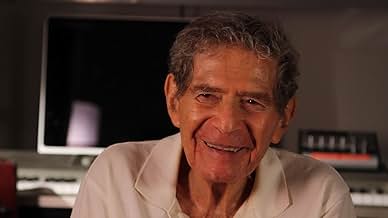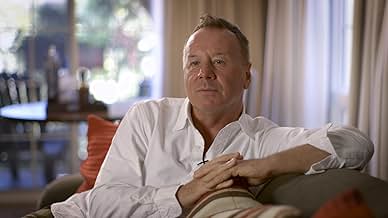Füge eine Handlung in deiner Sprache hinzuIn 1982, a small radio station battles to bring the New Wave to America.In 1982, a small radio station battles to bring the New Wave to America.In 1982, a small radio station battles to bring the New Wave to America.
M. King Adkins
- Self
- (as Dr. M. King Adkins)
Pete Byrne
- Self - Lead Singer, Naked Eyes
- (as Peter Byrne)
Empfohlene Bewertungen
Something that bothered me when I watched this was that there was no mention at all of the station that immediately followed LIR on the airwave. The wikipedia page basically lists them both as one entity The movie producers clearly chose to ignore the reincarnation of the station, which I didn't mind if they hadn't done it without making a single mention of the WDRE station that succeeded LIR. To leave it out without a mention, even a sentence in the epilogue, makes it seem pretty obvious that they went far out of their way not to mention the later station.
At some point the new station took the old LIR moniker, the movie could have helped clear up the confusion about the call letters by explaining what happened with the call letters over time, but by leaving it out they only added to it.
At some point the new station took the old LIR moniker, the movie could have helped clear up the confusion about the call letters by explaining what happened with the call letters over time, but by leaving it out they only added to it.
WLIR, founded in 1959, was the first FM radio station in Long Island, broadcasting mainly showtunes and jazz-pop. In the '70s, WLIR changed their format to Southern and progressive rock, but in 1982 became an underground phenomenon by being the first radio station in the country to play New Wave (mostly coming out of the UK) and post-punk music (in other words, exchanging the Allman Brothers and Blue Öyster Cult for Duran Duran and U2). Thumbing their nose at US record labels--who usually dictated to radio stations what they should be playing--the station became home to a lot of European music acts who were big in their home countries but brand new to Americans. In the days before the internet, radio "found" the new music/tomorrow's hits (for instance, WLIR broke Frankie Goes to Hollywood's "Relax" six months before the rest of the US heard it), and the gratitude from the musicians--many of whom are interviewed here--is genuine and joyous. Something different, to be sure, and very entertaining for music buffs. *** from ****
I know for sure that 2 college radio stations in the Boston area, WERS and WMBR, and 2 commercial stations - WBCN in Boston and KROQ in Los Angeles - were among various American radio stations that turned people on to many of the bands that WLIR claimed to have been "the first" to, and by several years. I was annoyed by how DJ's and staff in the film patted themselves on the back in taking such credit. WLIR changed format in 1982. U2's first album was released in the US 2 years earlier and was played at all the stations cited. That's just one example. Sure, WLIR helped expose the music which generated album sales, but don't claim something that is not true. It diminishes the legitimacy of the documentary. I cringed watching it. The listeners and staff obviously dug the commercial alternative format and the filmmaker shows that. I did enjoy seeing musicians that I liked remembering those days. Overall, great that 'LIR dared to be different but don't make false claims that you were the first, etc. And nobody likes a braggart anyway.
In 1982 I was 18 and a year out of high school. It was amazing to here about the clubs I used to frequent, the artists that started out of Long Island and that even thought at the time I didn't know it, and I'm sure none of us did, WHAT an impact it really was to the music world and how proud I am that I was part of that.... Definitely a film to keep in my collection. Thanks for the Memories.
I echo the sentiment of the Southern California reviewers. "New Wave" music was introduced into North America in many locations in parallel. We had a local university radio station playing this music circa 1977-78. It took a while for the mainstream FM stations to introduce this music to their playlists but it was here and available for listening well before 1982 on FM radio, TV and album imports. I suppose it was a gamble for an FM radio station to go full New Wave in 1982 but certainly not pioneering as this documentary alludes to.
The documentary was somewhat confusing, jumping all over the place with respect to artists and dates. Information presented chronologically would have been clearer.
The documentary was somewhat confusing, jumping all over the place with respect to artists and dates. Information presented chronologically would have been clearer.
Wusstest du schon
- Zitate
Michael Pagnotta: It was a movement in technology. And the difference between what Vince Clarke or Martin Gore, as opposed to what Keith Emerson could do, was completely different. The battery of keyboards that Wakeman and Emerson had to have on stage, I was the biggest Yes and the biggest ELP fan, so I love the sound of the Moog synthesizer. But, that was not a portable situation.
- SoundtracksMy Way
(Comme d'Habitude)
Music by Claude François and Jacques Revaux
French lyrics by Gilles Thibaut
English lyrics by Paul Anka
Performed by Sid Vicious
Top-Auswahl
Melde dich zum Bewerten an und greife auf die Watchlist für personalisierte Empfehlungen zu.
Details
- Erscheinungsdatum
- Herkunftsland
- Offizieller Standort
- Sprache
- Auch bekannt als
- Посмей быть другим
- Drehorte
- Los Angeles, Kalifornien, USA(on location)
- Produktionsfirmen
- Weitere beteiligte Unternehmen bei IMDbPro anzeigen
- Laufzeit1 Stunde 35 Minuten
- Farbe
Zu dieser Seite beitragen
Bearbeitung vorschlagen oder fehlenden Inhalt hinzufügen

Oberste Lücke
By what name was Dare to Be Different (2017) officially released in Canada in English?
Antwort






















